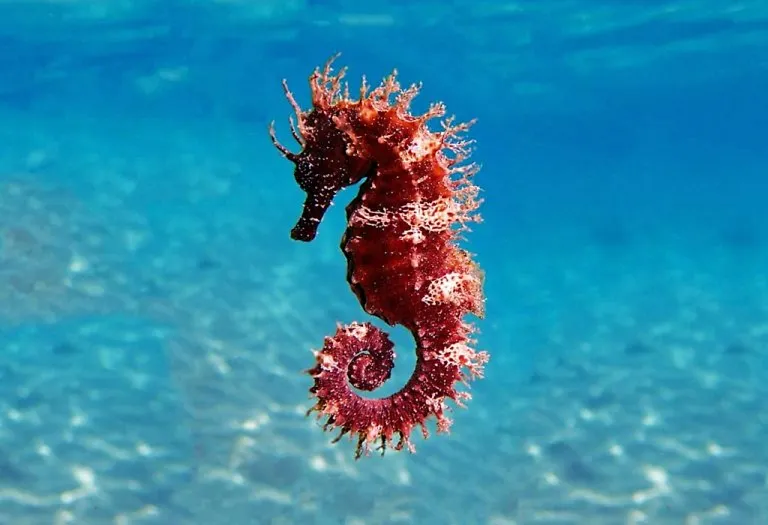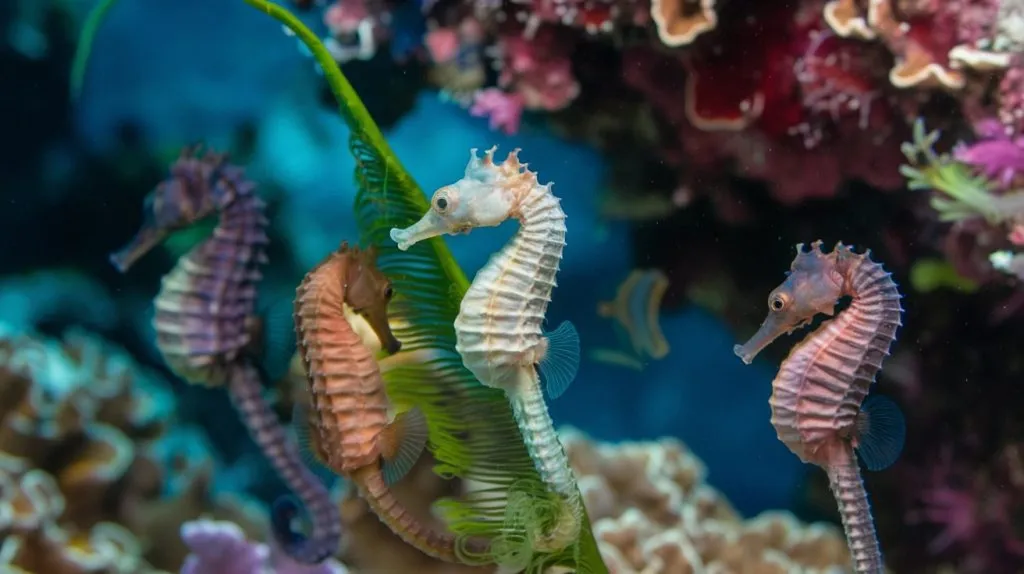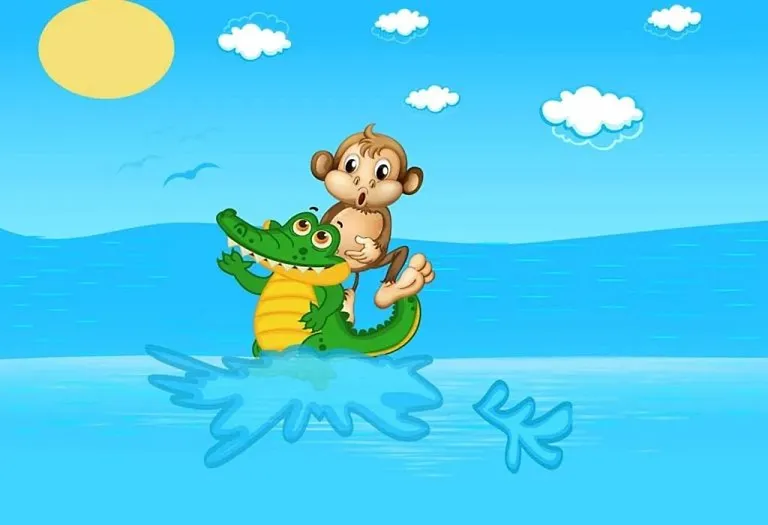Interesting Facts and Information About Seahorse for Kids
Seahorses are epic creatures. Ever imagined a tiny, unique fish with a face that resembles a horse and a curved body? Yep, those ate seahorses. These fish prefer to live in oceans, particularly in warm waters and are absolutely Instagrammable. It’s not just the structure that fascinates people; there is so much more to learn about seahorses for kids. Read all about seahorses facts to have an exciting conversation with kids and enrich their knowledge about sea creatures. These fish provide a perfect opportunity for kids to explore the magnificent marine world out there and grow up to be respectful and responsible adults towards the marine life. Without any delay, let’s quickly learn about the seahorse facts for preschoolers & kids.
What Is Seahorse and What Is Its Scientific Name?
A seahorse is a sea creature that gets its name from the horse because of its appearance. There are about 70 seahorse species in the world with horse-like heads.
- The scientific name of a seahorse is Hippocampus.
- They only live for about one to five years in their natural habitat.
- They generally live in shallow waters except in colder areas.
- They swim upright because of their fins ( dorsal fins) at the back.
- Seahorses can change color from black to grey to bright yellow and orange, which helps them keep safe from predators.
- Seahorses are vulnerable and on the verge of being endangered because of their use in Asian medicine.
- They are very small, and only one out of a thousand babies grow into adults.
- Each species of seahorse has a different number of plated rings running through the length of the body.
- Each seahorse has a slightly different part on the top of its head called a coronet to distinguish them from one other.
- Male seahorses give birth to babies and have a pocket like a pouch near their abdomen.
Types and Species of Seahorses
While all seahorses are identical in shape, with about 70 species worldwide, different kinds of seahorses are of different sizes and colours. Some trivia about types and species of seahorses:
- The smallest seahorse species is the pygmy seahorse, which is smaller than a fingernail.
- The big-bellied seahorse is the largest seahorse, as tall as one foot.
- Scientists have discovered more than a dozen species of seahorses in the last decade.
- Seahorses can have a short snout or a long snout.
- The leafy sea dragons are closely related to seahorses but have leaf-like arms and legs that flow.
Family Life of the Seahorses
Scientists and researchers have spent a lot of time trying to unearth the peculiar way sea horses mate and live. The mating and family practices of sea horses differ from other fish.
- A group of seahorses is called a herd.
- A baby seahorse is known as fry.
- Each seahorse chooses a mate and stays with the same mate for its entire life.
- Although they choose a mate for life, male seahorses live in separate territories and get together every morning to perform a ritual dance.
- Male seahorses carry the eggs in a pouch located in the front of their body until they are ready to hatch.
- It takes about 45 days for seahorse eggs to hatch.
- Newborn seahorses swim together and stay connected with their tails, which is a survival technique against predators.
- Baby seahorses must learn to survive once they are born without any help from their parents.
What Is the Size of a Seahorse
It is small and strange in its appearance; seahorses survive in dangerous zones because of their exterior. Seahorses can be as small as half an inch or as tall as 14 inches. Adult seahorses can measure from 1 to 30 centimetres in length.
What Is the Behaviour of Seahorses?
Seahorses are certainly unique creatures that are known for their slow and gentle behaviour and deliberate actions. Let’s learn a bit more about them:
1. Slow swimmers
Seahorses are absolute slow swimmers and use their dorself to propel themselves forward.
2. Camouflage
Seahorses are pro at camouflaging themselves to protect themselves from predators. They usually hide in corals and seaweed changing their colour to their surroundings.
3. Pregnancy in Male
Surprisingly, seahorses are one of the rare species on this planet where males become pregnant and give birth to baby seahorses called “fry.”
4. Mating Ritual
Male seahorses perform dances for the female seahorses and wrap their tails around the females during courtship. They even change their colour.
5. Communication
Seahorses use their bodies to communicate with other seahorses and marine creatures. Changing body colour and posture, using tails, and using vocal sounds like chirps and clicks are some communication ways of seahorses.
6. Solitary
Seahorses prefer solitude and only communicate to other seahorses when they have to mate.
Where Do They Live?
Seahorses tend to live in warm water near coastal regions around the world. They like shallow waters as many plants to hold on to. They live typically in coral reefs, seagrass meadows, and mangroves. Seahorses stay in close proximity to their homes for all their lives.
What Do Seahorses Eat?
Seahorses don’t have stomachs and eat by suctioning their food through their snout. Their diet consists of plankton, crustaceans, copepods, and shrimps. Seahorses can eat up to 3000 brine shrimps in a day. They are skilled ambush predators and wait for their prey to pass by. Food passes through their digestive tract, which is why they eat up to 50 times a day!
How Long Do They Live?
The lifespan of seahorses is not known and is ascertained by observations. The known lifespans of species range from one year for the smallest species to about 3-5 years for the larger species.
How Do Seahorses Swim?
Seahorses swim vertically and have a fin on the back of the head that propels them forward. This helps them flutter at a speed of 35 times per second. They can move in different directions with their pectoral fin. They hold on to plants underwater with their curly tails. This also helps to catch food or preserve energy in rough waters. The swimming bladder is an air pocket located inside the body and releases or adds air when the seahorse wants to move up or down. Seahorses are not good swimmers and have bony plates that cover their bodies instead of scales.
Where Do Seahorses Found Across the World?
Four species of seahorses are found in the Pacific across North and South America. They are commonly found off the coasts of every continent except Antarctica. Seahorses live in areas above or below the equator and do not stay in coastlines where water tends to be cold most of the year. They can live in areas with a wide range of salinity, and it helps them navigate in estuaries and mangrove forests.
Other Amazing Facts and Information About the Seahorse for Children
You now pretty much know a lot about the entire life of seahorses, from their birth, size, and habitat to reproduction details. Well, that’s not it. There’s plenty seahorse facts for kids that make up everyone flabbergasted. There are some interesting seahorse fun facts that you can share with kids at a glance that may well be helpful to them in their next science project or quiz.
- The female seahorse lays about 200 eggs in the pocket pouch of the male seahorse through an egg-laying tube.
- Male seahorses fight for female attention by wrestling with their tails.
- Seahorses are capable of looking forward and backward.
- They are bad swimmers and try to latch on to seaweed and other ocean debris to travel long distances in the ocean.
- Seahorses have a tough exoskeleton and have a spiny and bony body.
- Seahorses have very sharp eyesight that helps them hunt for their prey.
- With a huge demand for seahorses in Asian medicine, they are on the brink of being endangered.
- The scientific name of a seahorse, “Hippocampus,” means a “Horse Caterpillar” in Latin.
- Seahorses are slower than snails and can cover a distance of just five feet in at five feet in an hour.
- Seahorses love to swim in pairs together, holding tails and staying side by side.
- Seahorses cannot bend their tail backwards.
- Seahorses make strange sounds while eating and trying to communicate with other seahorses.
- These fish are typically found in warm waters, i.e. tropical regions.You can also find them in mangrove swamps, estuaries, coral reefs, and shallow waters.
- Male and female seahorses live close to each other. However, their home sizes are quite different. While females live in an area of about 100 square metres, males, surprisingly, have an area of only about 0.5 square metres.
- Seahorses have danger from crabs, sharks, and rays.
FAQs
1. Are seahorses endangered species?
Yes, 40% of seahorse species are considered endangered and threatened with extinction, according to the International Union for the Conservation of Nature (IUCN). Overfishing, habitat destruction, and lack of habitat protection is leading seahorses to their extinction.
2. What is the largest and smallest known seahorse?
The big-bellied or pot-bellied seahorse, about over one foot tall, is the largest seahorse, and the pygmy seahorse is the smallest seahorse, smaller than a fingernail in size.
3. Do seahorses have cultural associations?
You may find references to seahorses in several Greek and Roman mythical stories. Despite their actual size, you may find them being portrayed as big and bulky creatures. Because of their unique appearance and rarity, they have found a special place in the world of fantasy.
We hope your kiddo loved these seahorse facts for kindergarten kids and is now fully inspired to explore the whole marine ecosystem. With so much interesting trivia and facts to learn about sea horses, you could have a fun interactive session with children. Their curious minds are constantly seeking information, and the above information could suffice to pique their curiosity.
Also Read:
Sea Turtles Facts for Kids
Starfish Facts for Children
Blue Whale Facts for Kids
Information About Dolphins for Kids
Was This Article Helpful?
Parenting is a huge responsibility, for you as a caregiver, but also for us as a parenting content platform. We understand that and take our responsibility of creating credible content seriously. FirstCry Parenting articles are written and published only after extensive research using factually sound references to deliver quality content that is accurate, validated by experts, and completely reliable. To understand how we go about creating content that is credible, read our editorial policy here.























